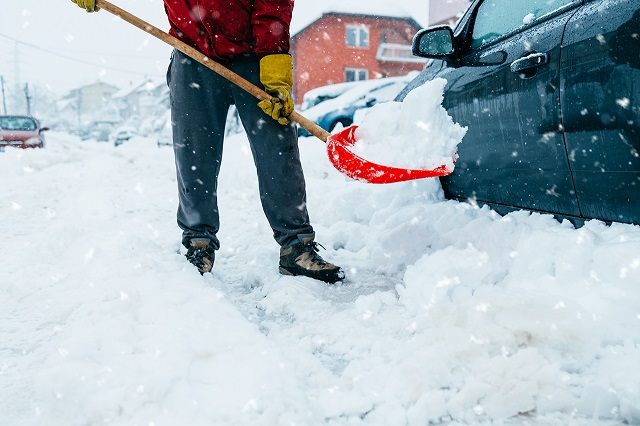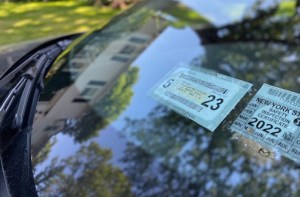Whether you buy or build one, it’s always smart to keep an emergency roadside kit in your car — you never know when you might need it.
Before winter arrives, consider supplementing your kit with a few extra tools and supplies to help you stay safe in the season’s toughest conditions.
Year-Round Roadside Kit Essentials
There are a handful of items you should always keep handy for driving emergencies. These include:
- First aid kit with extra medication.
- Jumper cables or jump pack.
- Portable air compressor.
- Extra cell phone charger.
- Flashlight.
- Jack, lug wrench and a spare tire.
- Non-perishable food and water.
- Road flares or reflective triangles.
- Toolkit.

Winter Driving Kit Additions
Shovel / Long-Handled Snow Brush or Broom / Ice Scrapper
Clearing snow off your vehicle and digging it out are two of the most common winter driving challenges. You’ll need at least these three tools in your winter driving emergency kit to effectively get the job done.
A shovel can help you clear a path around the car, as well as in front of and behind all four tires. Collapsible shovels are available for easy storage. A long-handled snow brush or broom should be used to remove snow from the vehicle itself. An ice scraper is the right tool to clear your windshield and windows when the winter weather has frozen over.
Kitty Litter / Sand
If you’re stuck in a slippery patch of snow and ice, kitty litter and/or sand can be your best friend. These substances help improve traction, allowing your tires to grip the road and propel the vehicle forward.
Camping Blanket
Staying warm will be one of your main priorities — and obstacles — if you’re in a winter roadside emergency. A blanket can go a long way in this situation. Your best bet is to look for a camping-style blanket that can be packed up tightly to easily fit in your car.
Lock and Windshield De-Icer
You can’t drive your car if you can’t get inside. Your locks can easily freeze shut if any type of precipitation is followed by plunging temperatures. De-icers can help thaw the lock and windshield quickly and get you on your way.
Rain Poncho
Wearing wet clothes in cold weather can cause hypothermia. For only a few dollars, a simple poncho can protect you and your clothes from the rain and snow. Plus, it can fold up inside a compact package to easily store in your winter driving kit.
Boots, Gloves, Hats
You may be best off keeping an entire extra set of warm clothes in your car. But if you have to narrow it down, make sure to have warm, dry sets of boots and gloves on hand, as well as a winter hat.
Your hands and feet are most likely to come in contact with the snow. Plus, extremities are often the first body parts to feel the effects of cold weather, so making sure these body parts are protected and well-insulated is vital. As for your head, heat escapes from every area of your body, so keeping your noggin uncovered is a mistake.
Hand and Feet Warmers
For an extra layer of protection, stock up on hand and feet warmers.
Extra Windshield Wiper and Fluid
Winter weather is particularly taxing on your vehicle. The onslaught of rain, snow, sleet and ice means your wipers will be working overtime. But this weather can also cause wipers to break. Keeping your windshield clear is paramount in safely operating a vehicle, so you don’t want to be stranded without effective wipers (or enough wiper fluid).
Pro tip: When replacing your wipers as part of regular car maintenance, save the old wipers for emergencies.
Sports Drinks
We know that it’s always a good idea to have extra water in your vehicle. In the winter months, however, you may want to supplement your hydration supply with sports drinks, which typically freeze at a lower temperature than water.
Additional Warning Devices (Flares and Reflective Triangles)
Warning devices should be part of your year-round roadside kit, but you’re more likely to use them in the colder months. The sun sets earlier during the winter, increasing the odds that it will be dark outside while you’re dealing with your emergency. Being stuck on the side of the road in the dark without any (or enough) warning devices can be very dangerous.
If you need help, AAA Roadside Assistance is standing by 24/7.
What emergency items do you keep in your winter driving kit? Let us know in the comments below.
3 Thoughts on “Build Your Winter Driving Kit”
Leave A Comment
Comments are subject to moderation and may or may not be published at the editor’s discretion. Only comments that are relevant to the article and add value to the Your AAA community will be considered. Comments may be edited for clarity and length.














Newspaper – a piece of newspaper gives better traction when your tire is stuck in snow than cat litter or sand (both of which are great if you need extra weight in the back of your car). It takes up less space and no spills. When tucked up against the stuck tire(s) gives you instant traction on both snow and ice along with the added benefit of not shooting sand/kitty litter everywhere from a spinning tire. Just remember to pick up your piece of newspaper afterwards.
If you’re parking your car outside it helps when it snows or rain may freeze to slip a knee stock on each of the wipers to keep them from freezing to the wind shield.
I also keep a pair of sun glasses in my glove compartment year round. Snow reflects light and it can be easier to see when driving or while waiting for help.